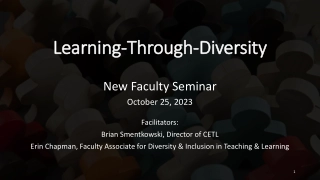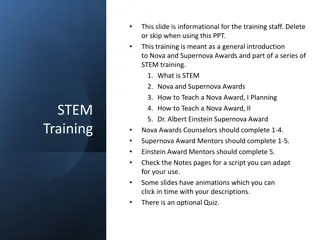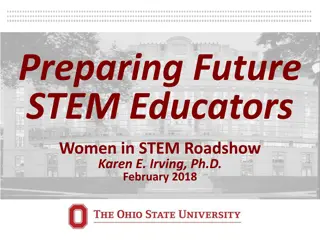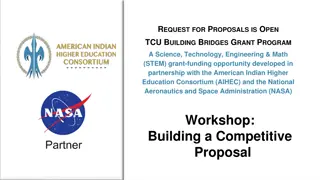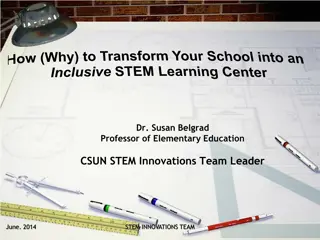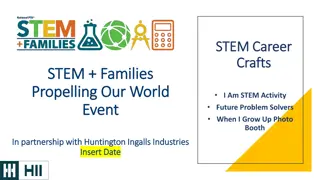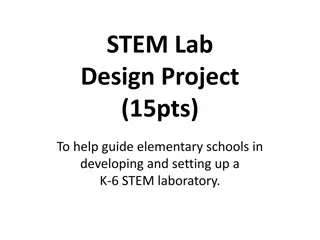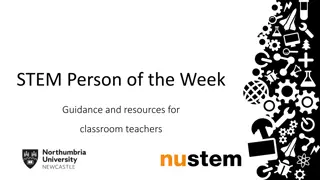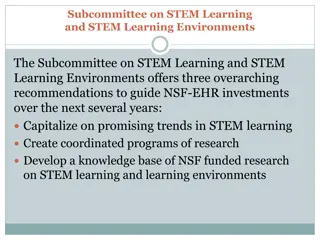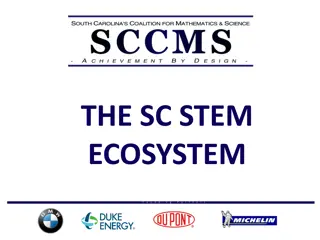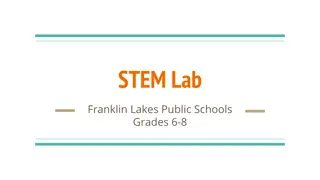Exploring the Importance and Integration of STEM Education
STEM education, encompassing science, technology, engineering, and mathematics, has gained significant importance in the early 2000s due to its crucial role in fostering innovation, addressing societal challenges, and enhancing economic competitiveness. The integration of these disciplines offers a holistic approach to problem-solving and technological advancement. Various variations of STEM have emerged, reflecting the diverse applications and interdisciplinary nature of this field. This comprehensive overview sheds light on the significance of STEM education and its impact on shaping future generations for a rapidly evolving world.
Download Presentation

Please find below an Image/Link to download the presentation.
The content on the website is provided AS IS for your information and personal use only. It may not be sold, licensed, or shared on other websites without obtaining consent from the author. Download presentation by click this link. If you encounter any issues during the download, it is possible that the publisher has removed the file from their server.
E N D
Presentation Transcript
Low Tech STEM Beth Harris | Synergy 2019
What is STEM? The acronym originated in the early 1990s although the concept was not new. Became official when NSF used in 2001.
What is STEM? Variations on a theme eSTEM (environmental STEM) STEMIE (Science, Technology, Engineering, Mathematics, Invention and Entrepreneurship) iSTEM (invigorating Science, Technology, Engineering, and Mathematics) STEMLE (Science, Technology, Engineering, Mathematics, Law and Economics) STEMS^2 (Science, Technology, Engineering, Mathematics, Social Sciences and Sense of Place) METALS (STEAM + Logic) STREM (Science, Technology, Robotics, Engineering, and Mathematics) STREAM (Science, Technology, Robotics, Engineering, Arts, and Mathematics) STEAM (Science, Technology, Engineering, Arts, and Mathematics) GEMS (Girls in Engineering, Math, and Science) STEMM (Science, Technology, Engineering, Mathematics, and Medicine) AMSEE (Applied Math, Science, Engineering, and Entrepreneurship) THAMES (Technology, Hands-On, Art, Mathematics, Engineering, Science) MINT (Mathematics, Informatics, Natural sciences and Technology)
Why STEM? In the early 2000s in the United States, the disciplines of science, technology, engineering, and mathematics became increasingly integrated following the publication of several key reports. In particular, Rising Above the Gathering Storm (2005), a report of the U.S. National Academies of Science, Engineering, and Medicine, emphasized the links between prosperity, knowledge-intensive jobs dependent on science and technology, and continued innovation to address societal problems. U.S. students were not achieving in the STEM disciplines at the same rate as students in other countries. The report predicted dire consequences if the country could not compete in the global economy as the result of a poorly prepared workforce. Thus, attention was focused on science, mathematics, and technology research; on economic policy; and on education. Those areas were seen as being crucial to maintaining U.S. prosperity https://www.britannica.com/topic/STEM-education
Why STEM? Or simply - jobs & the economy.
What makes STEM, STEM? Not just 4 subject but rather INTEGRATING. For example using science, math, and technology together with the engineering design process to solve a problem. Or engineering a new technology that will help you answer a science question. STEM at its best is problem or project based.
What makes STEM, STEM? Science = a way for creating knowledge about how the world works (scientific method) Engineering = a way of solving problems (engineering design process) Mathematics = the language of science & engineering Technology = the TOOLS that you use to do S, E and M (ie for measuring and building)
Technology in the dictionary: the application of scientific knowledge for practical purposes, especially in industry. machinery and equipment developed from the application of scientific knowledge. the branch of knowledge dealing with engineering or applied sciences.
Technology in Wikipedia: the collection of techniques, skills, methods, and processes used in the production of goods or services or in the accomplishment of objectives, such as scientific investigation.
Technology Technology does not have to involve a keyboard, coding, robots or 3D printing. There are plenty of rich, complex problems that are motivating, allow for creativity, use reasonable materials and are FUN.
Example 1 - Mechanical Engineering: Automaton Historical Automatons Automatons with Monks How to make them from the Exploratorium
Example 2: Computer Programming - Cup Stacking Robot Challenge: Write a program to tell a robot how to make a cup tower at least 3 cups tall. What you need to know: Robots, like computers, only do what you tell them to do. The programs that control robots are just a series of commands that tell the robot how to move. To tell a robot to build a cup tower you need just 5 symbols.
Example 2: Computer Programming - Cup Stacking Robot Challenge: Write a program to tell a robot how to make a cup tower at least 3 cups tall. A program to make a simple 3 cup tower would look like this: Can you follow the code to build the tower?
Example 2: Computer Programming - Cup Stacking Robot Challenge: Write a program to tell a robot how to make a cup tower at least 3 cups tall. Use the paper, pencil and cups with a partner to write the code for a 3 cup tall tower. Use the 4 arrows and a circular arrow (to flip the cup upside down) OR other symbols that you define. Once your code is complete, switch with another group. Can you follow their code to build the tower?
Example 2: Computer Programming - Cup Stacking Robot Were you successful? What is the smallest number of cups you need to make a tower 3 cups high? What is the smallest number of symbols you need to make a tower 3 cups high? Take it further! Functions = a section of code that is repeated often More at https://csunplugged.org
Example 3: Electrical Engineering - Steady Hand Game Challenge: Make a steady hand game using an electric circuit. What you need to know: The goal of a steady hand game is to carefully move a loop around a wire shape without touching the wire. If you do touch the wire, an electric circuit connects which causes a bulb to light or buzzer to sound. As the name implies only a very steady hand will succeed. Making the game is much easier. Simply create a circuit inside a box that connects the wire shape to the light or buzzer, then to the battery, wire loop and back to the other end of the wire shape.
Example 3: Electrical Engineering - Steady Hand Game Challenge: Make a steady hand game using an electric circuit. First - make the buzzer buzz, Then - attempt the challenge
Questions? Beth Harris http://seven-oaks.net beth@seven-oaks.net



